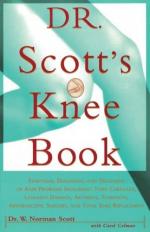|
This section contains 299 words (approx. 1 page at 300 words per page) |
Cartilage is connective tissue that lacks blood vessels, and functions to bind structures together or provide support. Cartilage cushions organs and articulating (flexing) joints in the body. In an embryo, some of the precursors to bones are made of cartilage. Ribs, ears and the nose are also made of cartilage.
Typical of connective tissue, cartilage is composed of glycosaminoglycans, proteoglycans, and glycoproteins. Cells called chondroblasts produce these compounds. Additionally, with the exception of cartilage found in articulating joints, cartilage is covered with a connective tissue later called the perichondrium.
There are three mains types of cartilage: hyaline cartilage, elastic cartilage, and fibrocartilage. Hyaline cartilage gets its name from its translucent (hyaline) appearance. The collagen and elastin fibers cannot be seen. It is the most common and best-studied form of cartilage. The elastic cartilage is found in the ear, auditory canals of the outer ear, and in the larynx. It is essentially hyaline cartilage enriched in fibers made out of elastin. These fibers are visible under microscopic magnification. The presence of more elastin confers a more elastic quality to the cartilage relative to hyaline cartilage. Fibrocartilage represents an intermediate between regular connective tissue and hyaline cartilage. It is located in some ligaments, the public region of the body and in the intervertebral discs of the spine.
Cartilage damage is infamous as the source of knee pain for many people. In the knee, cartilage comprises the meniscus. Tears can occur in the meniscus due to injury (often sports-related) and age-related deterioration. Because the majority of the meniscus does not have a blood supply, the normal healing process that occurs elsewhere in the body does not occur in the knee. The torn meniscus causes abnormal, often painful movement of the knee joint. Surgical intervention is usually necessary to effect repair.
|
This section contains 299 words (approx. 1 page at 300 words per page) |


